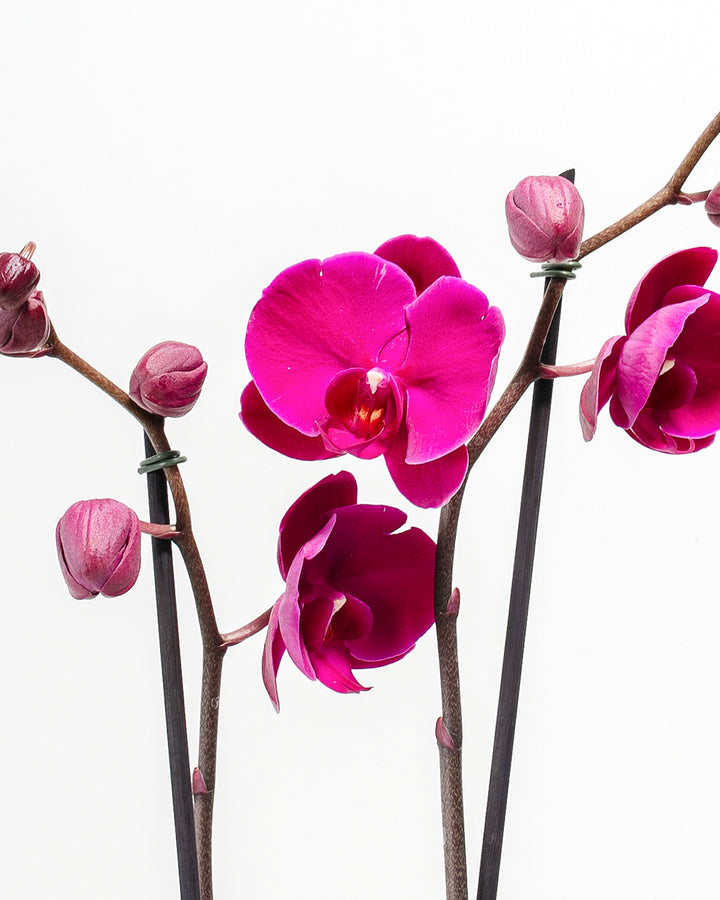Welcome
You have points
Recently viewed
Wishlist
Sign in to access your favorites

The Purple Phalaenopsis Orchid, commonly known as the Purple Moth Orchid for its wing-like blooms, is a striking houseplant known for its vibrant purple petals. Its botanical name, Phalaenopsis spp., reflects its place among the most beloved flowering orchids worldwide. Native to Southeast Asia, this flowering plant thrives in USDA hardiness zones 10-12 and is best suited for bright, indirect light. While it requires moderate care, its elegance makes it a favorite for both beginners and seasoned plant enthusiasts.
Unlike many houseplants, the Purple Phalaenopsis is considered pet-friendly, adding to its appeal for households with furry friends. This orchid symbolizes elegance, admiration, and grace, making it a perfect plant gift or centerpiece.
You can also explore other stunning Orchid varieties featured below:
The Purple Moth Orchid is a low-maintenance plant that thrives with some basic care, making it perfect for plant enthusiasts of all experience levels. Follow these simple guidelines to ensure your orchid remains vibrant and healthy.
Water your orchid once weekly, or every 10 days, allowing the roots to dry out between waterings. Use room temperature, filtered water to avoid shocking the plant. Orchids prefer high humidity labels (%60-70%), so consider using a pebble tray or humidifier to maintain ideal conditions.
Place your Purple Orchid in bright, indirect sunlight; avoid direct sunlight as it can scorch the delicate leaves and flowers. This orchid thrives in temperatures between 65–75°F (18–24°C) and prefers stable conditions without sudden drafts or temperature drops.
Use a specialized orchid potting mix containing bark or sphagnum moss for excellent aeration and drainage. Repot your dark purple orchid every 1-2 years or when its potting medium begins to break down. Always use a pot with good drainage to prevent root rot.
Feed your violet orchids with a balanced orchid fertilizer every two weeks during its growing season, and reduce feeding during dormancy. Propagation is typically done through keikis (baby plants) that form on the flower spikes. Once mature, they can be detached and planted in fresh orchid mix.
If your Purple Moth Orchid has yellow leaves it can indicate overwatering, while brown or crispy edges may result from insufficient humidity. If your orchid isn’t blooming, ensure it receives enough light and maintain a temperature drop of about 10°F at night to stimulate flowering. Regularly check for pests like mealybugs and treat with insecticidal soap if necessary.
Orchids are stunning pet-friendly plants with vibrant, long-lasting blooms that elevate any space. When the flowers eventually fade, the beauty doesn’t have to end - thanks to our Orchid Subscription. Receive a handpicked, freshly blooming orchid every 3 to 6 months, ensuring your home is always adorned with floral elegance. Each orchid comes in an Eco Pot, offering variety and convenience for orchid enthusiasts.
Enhance your Purple Orchid’s beauty with these vibrant companion plants:
If you’re seeking other stunning indoor plant options, consider these vibrant alternatives:
Bring home a stunning purple orchid from Lively Root today and add a touch of elegance to your space.
Follow us @livelyroot & show us your #livelyroot plants

